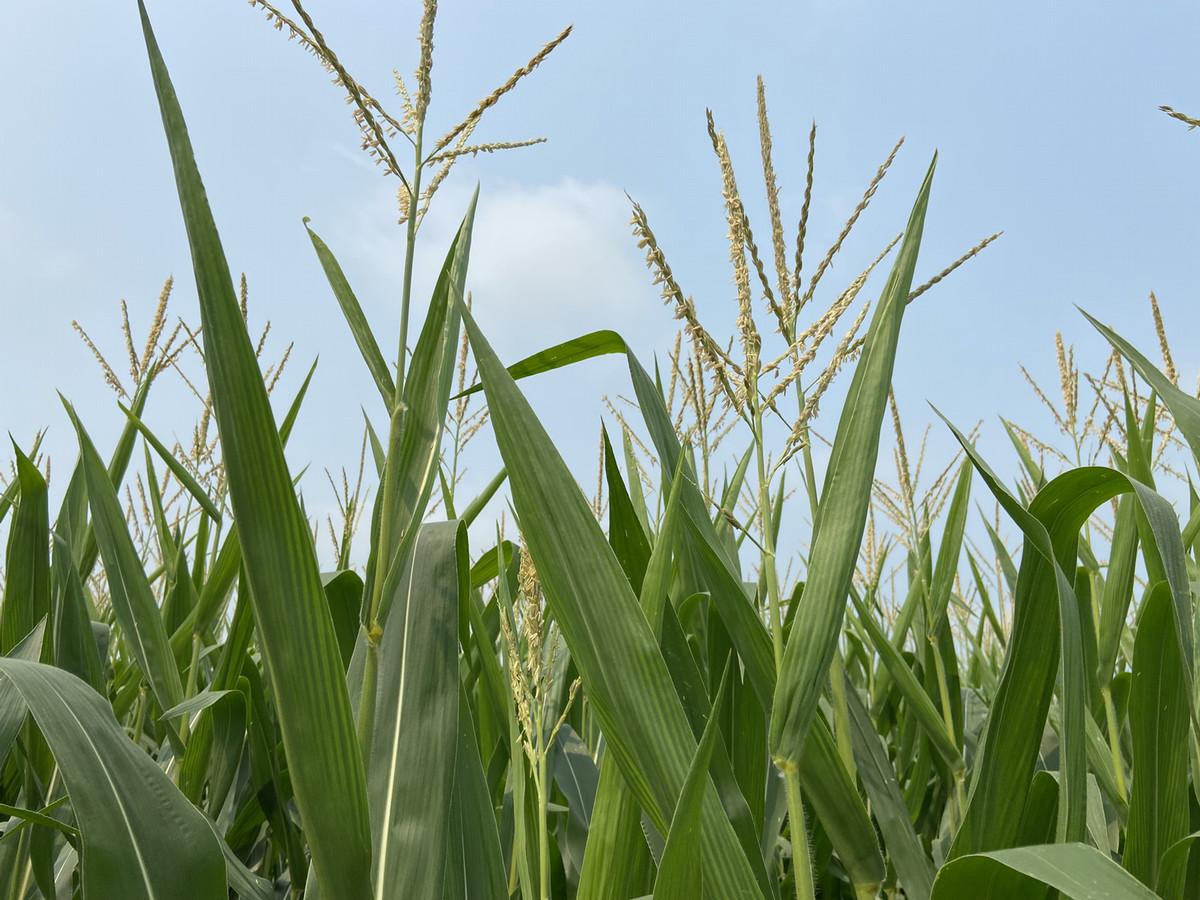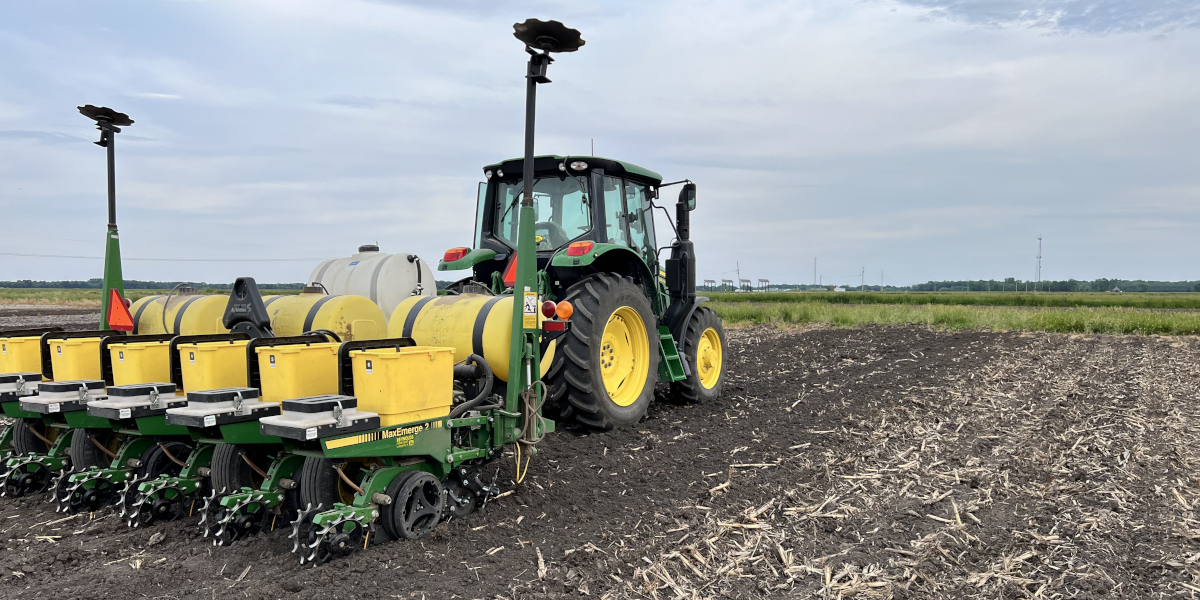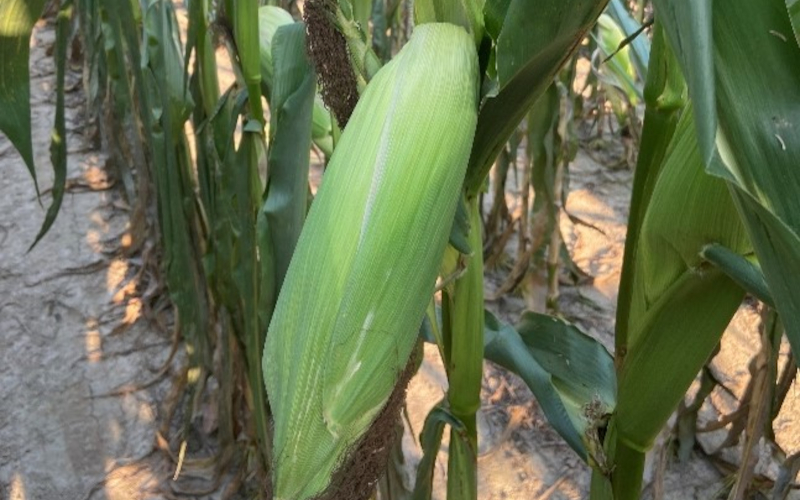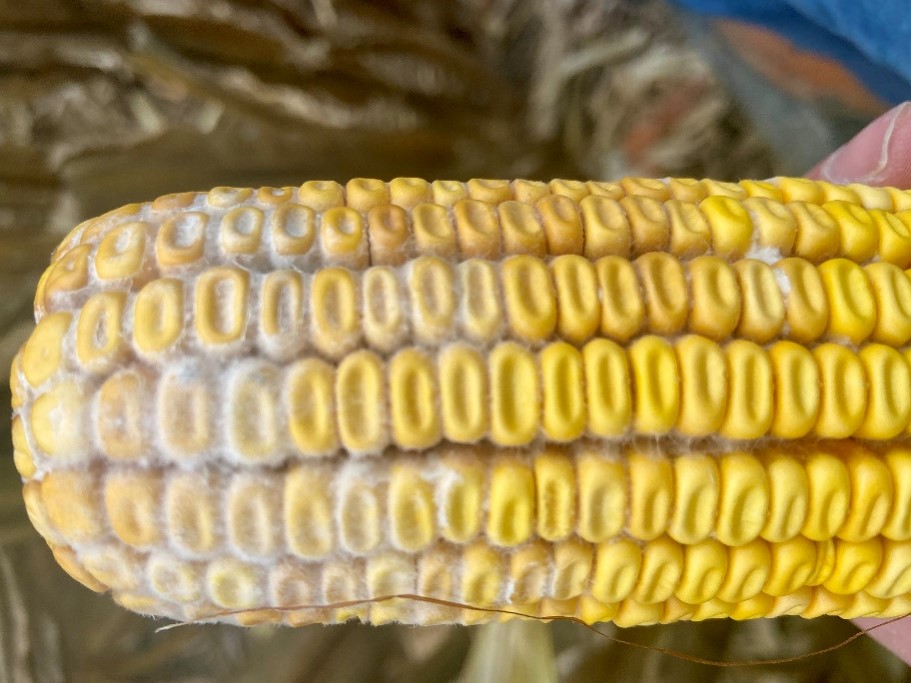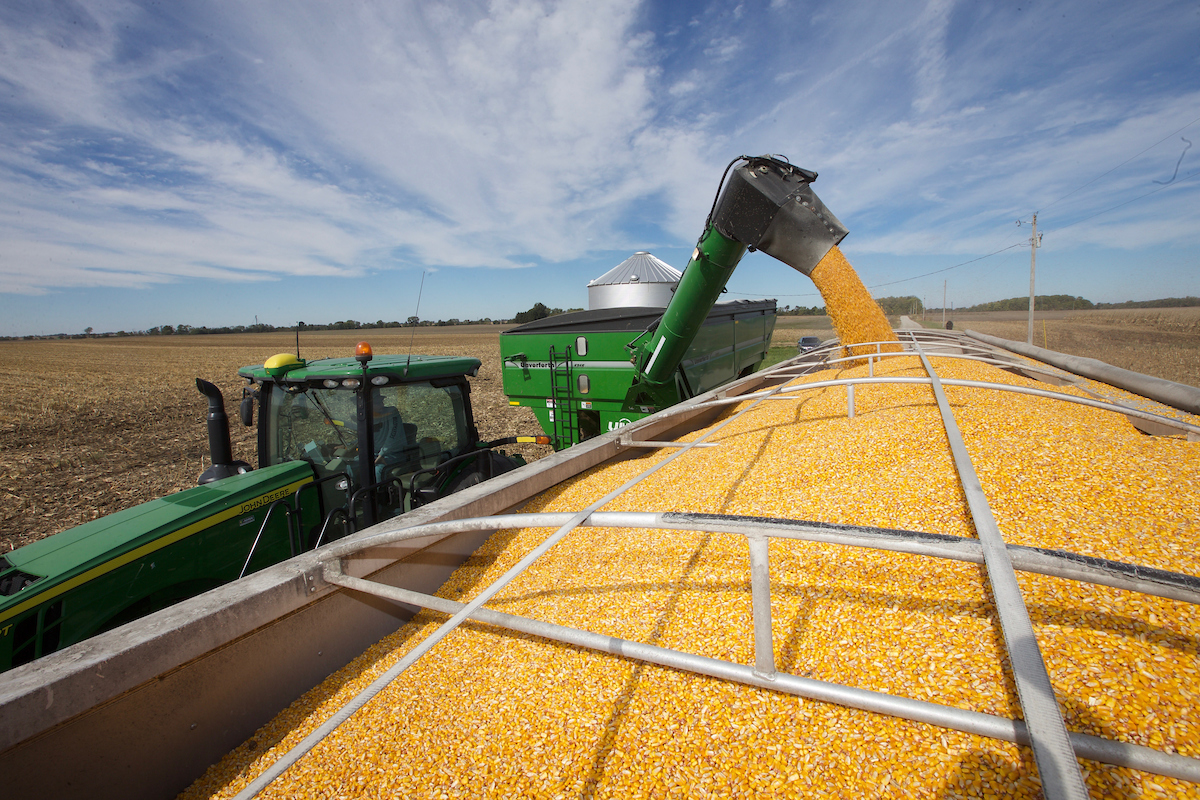Drought Stress and Indiana Corn in 2023
The biggest challenge so far this year for Indiana corn production has been the dry conditions experienced throughout the state (Figure 1). Despite timely planting progress in 2023 and overall good planting conditions, much of the crop condition has deteriorated over the month of June due to dry conditions. For example, areas of Tippecanoe County have only experienced 0.6 inches of rainfall in June (87% decrease from the 30-yr average; Purdue Univ. Mesonet). In addition, crop condition rated good to excellent has declined from 72% (May 22) to 47% (June 26; Figure 2; USDA-NASS, 2023).
The main question that is often asked is “how much yield potential am I losing?”, which can often be a difficult question to answer because the nature of drought varies one year to another. Figure 2 highlights that in certain drought years (2002 and 2012) large reductions in state yield averages can occur in comparison to trend yield. Whereas, in other drought years (2007 and 2020), state yield averages can still be at or above trend yield. The unknown factor at this point in the 2023 growing season is we do not know how the drought will progress the remainder of the summer. Therefore, it is still difficult to determine where state yield average will be by the end of the season.
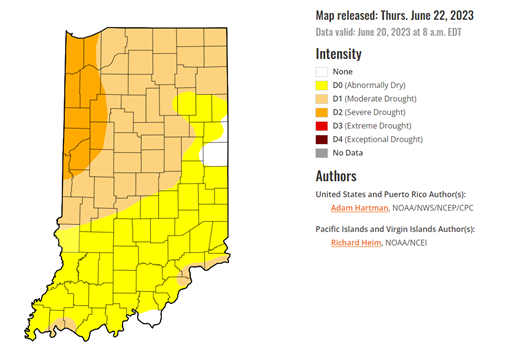
Figure 1. Indiana drought intensity and progress. June 22, 2023. Source: https://droughtmonitor.unl.edu/
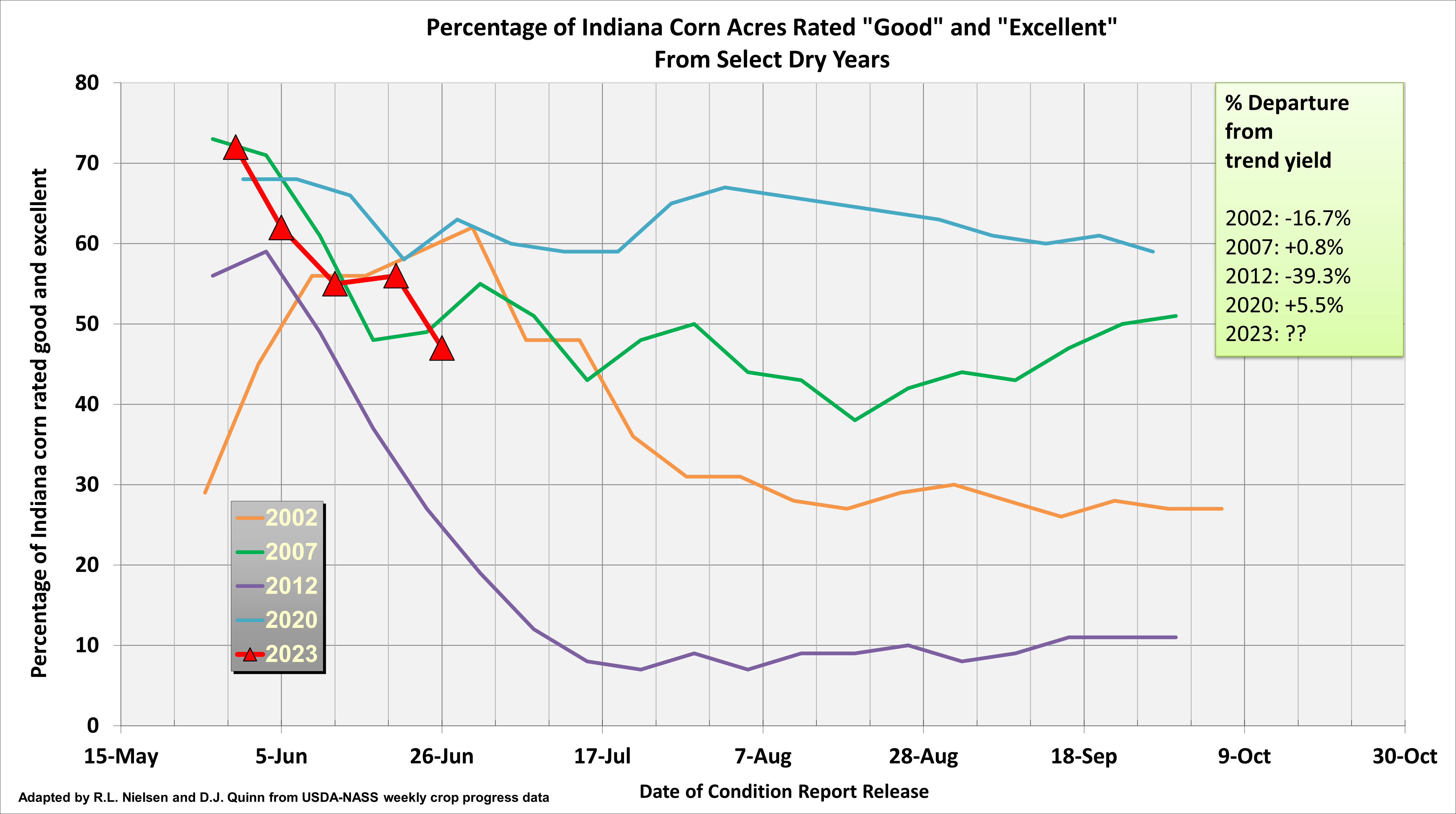
Figure 2. Weekly percentage ratings of corn rated “Good” and “Excellent” from in Indiana, 2023 in comparison to selected dry years (USDA-NASS Weekly Crop Progress, 2023). Red line with triangles highlights current condition ratings for 2023.
Drought Stress Impacts during Vegetative Growth Stages
Corn can be affected by drought conditions at each stage during the plant’s life cycle (Nielsen, 2023). However, corn can also tolerate drought conditions, better or worse, at different growth stages. Therefore, it is important to assess and understand how drought conditions can impact a corn plant at different stages during the season.
One of the biggest observed crop establishment and crop condition differences that has been observed in 2023 has been a function of planting date. Drought conditions did not begin to appear in the state until the last week of May (https://droughtmonitor.unl.edu/) and have continued to persist throughout June. Therefore, much of the corn planted at the beginning of May was well established and had good rooting depth by the time drought conditions began, which should provide some drought tolerance. Whereas, corn planted during the later half of May has become more susceptible to germination and establishment issues caused by the drought conditions.
Overall, corn in early vegetative growth stages is fairly tolerant to high temperatures and drought conditions. Dry conditions can encourage deeper rooting which will likely assist the corn plant with moisture access later in the season. However, issues and yield loss can still occur. Common issues observed in young plants experiencing drought stress include the desiccation and death of nodal root development causing “rootless” or “floppy” corn syndrome (Nielsen, 2022) and in severe cases, the outright death of young plants resulting in plant population losses.
One of the most noticeable symptoms of drought stress is leaf rolling, which is due to plants closing leaf stomates to limit the transpiration of moisture through the plants. Although the attempt to limit transpiration of moisture can help a stressed corn plant, stomates closed for a prolonged period can reduce plant photosynthesis due to reduced carbon dioxide accumulation. Severely drought stressed plants actually start to turn gray, which indicates death of the chlorophyll and a severe reduction in photosynthesis. The earlier leaf rolling occurs in the day and the longer the duration of leaf rolling is observed, the more stress the plant is under, and the more potential yield loss can occur. Yield loss estimates from previous research when drought stress and leaf rolling occur for four consecutive days or more are provided in Table 1.
With persistent drought stress and leaf rolling causing reduction in photosynthesis, drought stress during the vegetative growth stages can reduce overall plant and leaf size. For example, previous research has observed upwards of 28-32% reductions in final plant dry matter weight with persistent drought conditions during the rapid vegetative growth period (e.g., V6 – V14; Cakir, 2004). Reductions in plant and leaf size can reduce the overall photosynthetic “factory” of the plant, thus limiting optimum photosynthate production for kernel formation and grain weight later in the season.
Significant drought stress during vegetative growth can also reduce yield due to kernel number reductions caused by restricted ovule (potential kernel) formation during the rapid growth period (potential kernel number per row is more sensitive to environmental stress than kernel row number per ear). In addition, since dry soil conditions limit water uptake of a corn plant, nutrient uptake can also be limited. For example, potassium deficiency is often observed under drought stress conditions. Unfortunately, applying more potassium fertilizer will not help alleviate this issue.
Table 1. Corn percent yield loss per day estimates when drought stress for four or more consecutive days (adapted from Classen and Shaw, 1970; Rhoads and Bennet, 1990; Shaw, 1988, Licht and Archontoulis, 2017).
|
Corn Growth Stage |
Percent estimated yield loss per day of observed drought stress (%) |
|
Early Vegetative Growth (VE – V12) |
1 – 3 |
|
Late Vegetative Growth (V12 – VT) |
2 – 5 |
|
Pollination to Blister (R2) |
3 – 9 |
|
Milk (R3) |
3 – 6 |
|
Dough (R4) |
3 – 5 |
|
Dent (R5) |
2 – 4 |
|
Physiological Maturity (R6) |
0 |
Drought Stress Impacts during Reproductive Growth Stages
As corn approaches maximum height and pollination, this is when the risk of yield loss due to heat and drought stress is the greatest. Corn evapotranspiration increases from as plants get larger and peaks through silking and pollination and until the R2 growth stage (blister) before decreasing (Table 2). Corn needs approximately 0.32 inches per day of water during peak demand but temperature, humidity level, and cloud cover impact daily water use. Yield loss caused by drought conditions during the critical flowering period is often a result of a significant reduction in final kernel number due to failed pollination. Ao et al. (2020) observed a 14% reduction in final kernel number when drought stress began at the V14 growth stage. Significant heat and drought stress that occurs 7-10 days ahead of silking and throughout pollination can result in delayed silk emergence, reduced silk elongation, and silk desiccation. Once pollen shed has begun, a single corn plant will only shed pollen for approximately 7 days. Therefore, delayed silk emergence can cause poor synchrony with pollen shed, resulting in failed opportunities for pollen capture and fertilization of the ovules on the ear. Extreme heat stress (> 100-degrees F) can kill pollen but Indiana rarely experiences such temperatures. Furthermore, pollen shed does not occur on one single day and peak pollen shed typically occurs in the morning when temperatures are lower. Drought stress during the early reproductive stages can cause kernel abortion whereas drought stress after the milk stage of kernel development can reduce plant dry matter partitioning to the grain causing low weight kernels.
Table 2. Average corn evapotranspiration per day at specific growth stages and average total water use needed for each specific growth stage (adapted from Kranz et al., 2008; Jeschke, 2021).
|
Growth Stage |
Daily Evapotranspiration (in) |
Total Water Needed per Growth Stage (in) |
|
Emergence (VE) |
0.08 |
0.08 |
|
4-leaf (V4) |
0.10 |
1.8 |
|
8-leaf (V8) |
0.18 |
2.9 |
|
12-leaf (V12) |
0.26 |
1.8 |
|
Early Tassel (R1) |
0.32 |
3.8 |
|
Silking (R2) |
0.32 |
3.8 |
|
Blister Kernel (R3) |
0.32 |
1.9 |
|
Beginning Dent (R4) |
0.24 |
3.8 |
|
Full Dent (R5.5) |
0.20 |
3.8 |
|
Physiological Maturity (R6) |
0.10 |
1.4 |
Overall, corn is fairly tolerant to heat and drought conditions during early vegetative growth. However, if drought conditions continue to persist and severe plant stress is observed, plant photosynthetic capacity and yield can be lost. Where heat and drought stress can become a significant problem and impact yield the greatest is during pollination and silking due to poor synchrony between silk elongation and pollen shed, resulting in large reductions in final kernel number. In addition, reductions in overall plant and leaf size due to persistent drought conditions during the vegetative and rapid growth phases may also limit kernel formation and grain weight accumulation.
Additional Resources:
Cakir, R., 2004. Effect of water stress at different development stages on vegetative and reproductive growth of corn. Field Crops Res. 89:1-16.
Classen, M.M., and R.H. Shaw. 1970. Water deficit effects on corn. II. Grain components. Agron. J. 62:652-655.
Ao, S., M.P. Russelle, T. Varga, G.W. Feyereisen, and J.A. Coulter. 2020. Drought tolerance in maize is influenced by timing of drought stress initiation. Crop Sci. 60:1590-1606.
Jeschke, M., 2021. How early season drought affects your corn crop. Pioneer Agronomy. https://www.pioneer.com/us/agronomy/early-season-drought-corn.html#:~:text=Corn%20is%20less%20susceptible%20to,of%20kernels%20on%20the%20ear
Kranz, W.L., S. Irmak, S.J. van Donk, C. Dean Yonts, and D.L. Martin. 2008. Irrigation management for corn. Bull. G1850. University of Nebraska-Lincoln Ext. https://extensionpublications.unl.edu/assets/html/g1850/build/g1850.htm#:~:text=In%20Nebraska%2C%20total%20corn%20water,24%20inches%20in%20the%20east.
Lee, C., 2022. Watch corn water use over the next few weeks. University of Kentucky Ext. https://www.kygrains.info/blog/2022/6/16/watch-corn-water-use-over-the-next-few-weeks
Licht, M., and S. Archontoulis. 2017. Influence of drought on corn and soybean. ICM News. Iowa State Univ. Ext. https://crops.extension.iastate.edu/cropnews/2017/07/influence-drought-corn-and-soybean
Nielsen, R.L. 2020a. Early season drought stress in corn. Corny News Network, Purdue Ext. https://www.agry.purdue.edu/ext/corn/news/timeless/EarlySeasonDroughtStress.html
Nielsen, R.L. 2020b. Tassel emergence and pollen shed. Corny News Network, Purdue Ext. https://www.agry.purdue.edu/ext/corn/news/timeless/tassels.html
Nielsen, R.L. 2022. “Rootless” or “Floppy” Corn Syndrome. Corny News Network, Purdue Ext. https://www.agry.purdue.edu/ext/corn/news/timeless/floppycorn.html
Nielsen, R.L. 2023. Corn Responses to Drought Stress. Corny News Network, Purdue Ext. https://www.agry.purdue.edu/ext/corn/news/timeless/CornRespDrought.html
Rhodes, F.M., and J.M. Bennett. 1990. Irrigation of Agricultural Crops, Corn – Ch. 19, 569-596, eds. B.A. Stewart and D.R. Nielsen. Madison, WI. ASA-CSSA-SSSA.
USDA-NASS. 2023. United States Department of Agricultural-National Agricultural Statistics Service. Weekly Crop Progress and Condition Reports. https://www.nass.usda.gov/Statistics_by_State/Indiana/Publications/Crop_Progress_&_Condition/index.php?_ga=2.30680895.1289289406.1687952912-934772628.1687219608
